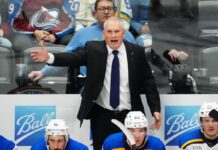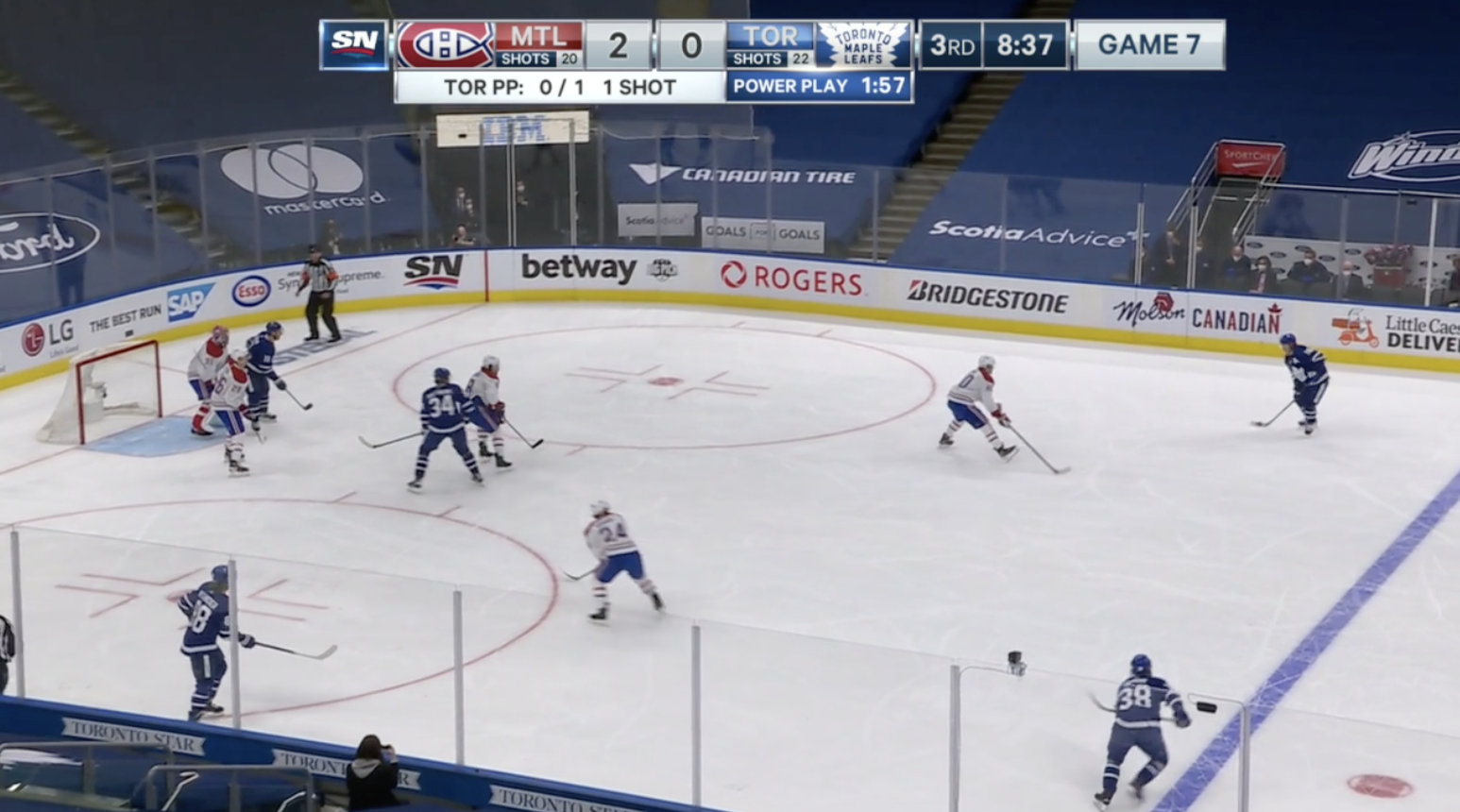After watching the Maple Leafs fail to start Game 6 with any semblance of intensity the other night, I’m not sure why we should have expected a different result in Game 7.
As I’m sure you’ve heard by now, Toronto lost 3-1 to Montreal, which now makes them 0-8 in closeout playoff games.
It’s easy to write a takedown piece after watching a collapse. “Trade this player, trade that player, fire this staff member, fire that staff member” — that’s the natural response we’re all feeling in the moment.
Even when I try to remove myself from the emotion of another Game 7 where the Leafs‘ best players didn’t play their best, something feels different this time around.
Maybe it’s the fact that this was their best 200-foot team in decades, finishing top five in the NHL in both chances for and against by any of the public or private metrics you’re using. Maybe it’s Auston Matthews and Mitch Marner putting up career years in the regular season — and coming up short offensively in this Montreal series.
Maybe it’s just the sheer frustration of watching the same result you’ve seen year after year.
For those of us who are pouring all these countless hours into watching (and for me, rewatching) the Leafs, you’ll see a game like tonight’s, or Game 6, or the David Ayers game, or any number of embarrassing performances in big moments, and be forced to ask yourself: “Why do I put myself through this?”
Are any of us happier for having watched this team? Does it make our lives any more meaningful? When they eventually get over the hump and experience some postseason success, I’m sure the emotional catharsis will be overwhelming, but as I sit here right now trying to assess the game I just watched, I can’t help but feel dejection.
Toronto had the easiest path they were ever going to have to a Stanley Cup final and they couldn’t even get past a significantly inferior Habs roster in the first round despite a 3-1 series advantage. The jokes write themselves.
To help wrap my head around everything, I’ll break the postgame column into a few key sections just like I always do. It helps me compartmentalize everything, so hopefully I can explore some of the major themes from tonight and how they might impact things moving forward.
I can’t imagine this will be a fun one to read (or write), but we’ll try our best to get through it together. Time for my final postgame Leafs column of the season, which is happening far earlier than I expected.
Again.
The Mitch Marner Problem
It doesn’t take an analytics guru to realize he hasn’t scored in his last 18 playoff games. The counterargument is that Nik Ehlers went 21 games without a playoff goal between 2018 and 2019. Should the Jets have traded him because of that? They were smart not to — he’s followed that up by consistently being their best player in 2021, despite Paul Maurice’s refusal to give him first-line minutes or PP1 duties.
That’s never been a problem for Marner, who continued to quarterback Toronto’s top unit power play from the half-wall in the highest leverage minutes of the season. Is that something the team should have seriously reconsidered given his play as of late? What about his spot on the top line with Matthews at 5v5?
There are a lot of “what ifs” we could look at throughout the series, but Marner is the player I keep coming back to whenever I re-watch shifts. In Game 7, with everything on the line, he was still shying away from 50-50 pucks, opting for the fly-bys we’ve seen far too often from Toronto’s star talent over the years.
6 shots through 2 periods for Leaf forwards. Way too many 50-50 pucks are lost, allows #Habs to get settled in D-zone..not enough defending under pressure so far
— Ray Ferraro (@rayferrarotsn) June 1, 2021
Here’s William Nylander for comparison.
We’ve all had our moments with Nylander throughout his career, but the one thing you can’t tell me is that he wasn’t engaged in this series. In fact, he was easily Toronto’s best forward at forcing turnovers and creating rush opportunities the other way.
No one expects him to be the most physically imposing player on the ice. You just want to see him engage in those 50-50 battles so his team stands a better chance at regaining possession. We didn’t see much of that from Marner in Game 7.
Now, is it even worth pointing out that Matthews and Marner scored on 1 of their 47 shots on net? No one in Toronto wants to hear the words “shooting two percent” brought up ever again. That was the excuse last year when they were “shooting two percent” at 5v5 against Columbus.
It’s also the excuse I kept hearing as to why you avoid Taylor Hall on the trade market, instead opting for the more defensively responsible Nick Foligno. No one could have foreseen Foligno suffering an injury that drastically impacted his value in these playoffs, but if you’re looking for a major Kyle Dubas criticism, that’s the move I’d bring up.
“This team doesn’t need more offense. You can’t keep adding skill.”
Frankly, I’ve always found this to be a weak argument in a sport where impacting goal differential is the main priority. Some players do that with offense, others do it with defense, but it’s an NHL front office’s job to identify the players who have the largest net impact and acquire them for as cheap as possible.
The Leafs made their bed by betting on their top four forwards to provide offense, surrounding them with defensive specialists to protect leads. Considering they led the NHL in time with the lead, you can understand the philosophy. Unfortunately, Toronto’s top forwards’ scoring dried up and their depth didn’t have the offensive firepower to supplement them with any goals.
Again.
This is frustrating for everyone involved, but how can we identify some of the trends that can help explain why this keeps happening? Is it just brutal puck luck? Are some of these players tragically flawed in the playoffs when it’s easier to expose some of their weaknesses?
At this point, I’m open to believing anything and completely re-evaluating my world views, but the clips I keep coming back to on a rewatch pertain to the power play.
How could the Leafs’ power play look this bad?
My focus tends to be on 5v5 play, considering how often referees even up the whistles or simply put them away in high-leverage moments of a crucial Game 6 or 7. That said, Toronto had two separate opportunities with the man advantage on Monday night.
When you pay this much for star talent, it’s because you can trust them to come out with a barrage of scoring chances on PP1 when given the opportunity. For anyone watching Colorado playoff hockey, that’s exactly what it looks like when they get the puck at 5v4 — impending doom for the opponent.
That hasn’t been the case for Toronto in months, failing to generate much of anything with the man advantage for long stretches. What’s funny is they actually had a few good looks on the PP in Game 7, but as a #TrustTheProcess nerd who tends to be way more worried about the procedure than the results, I have many concerns with how we got here.
This is how Toronto set up at 5v4 after a faceoff win with their season on the line.
Hyman
Nylander-Matthews-Marner
Sandin
The frustrating part for me is that I can see the logic. Marner is at his best as a passer from the right flank, but he needs a left-shot in the middle of the ice for the slap-pass option; otherwise, he’s pretty unthreatening as a passer. That forced Toronto to put Matthews in the bumper spot to give Marner the high-tip option, but it also takes away a lot of the magic #34 can create in open space from the wall.
I’m also not too keen on Hyman at the net-front considering he’s a right shot — opposing PKs can just sag off of him when Marner is holding the puck for too long on the right wall. Then again, your only viable left-shot option at the net front is probably Joe Thornton, which would’ve broken Leafs Twitter if he got yet another look on PP1.
This all stems from Marner’s unwillingness to play the goal-line at 5v4, which you can fact-check by asking the right people. Toronto’s best version of their power play all season was Nylander and Marner rotating along the left wall, with one of them playing the goal-line as a passer. It gave the top unit more flexibility, opened up passing lanes, created more motion and unpredictability.
But their $11 million winger wasn’t willing to do it.
I don’t know any of these guys personally, so I can only really evaluate the plays I see on the ice and try to make sense of them by re-watching the tape and diving into all of the available statistical information. I’ve done all that and my major takeaway is that stubbornness on PP1 cost Toronto their season.
How much of that blame you want to put on Marner, Manny Malhotra, or Sheldon Keefe is up to you. It’s a situation where the star player clearly needed to be played in a different role, didn’t want to do it, and the coaching staff wasn’t able to make the “difficult but right decision” to maximize results at the team level.
You never want to see anyone lose their job, but I can’t imagine Malhotra will be back next year considering how poor the power play he was in charge of has looked for long stretches. I still find it mind-boggling that the Leafs’ 5v4 goal differential was zero in the final 29 games of the season with a healthy John Tavares.
Five power-play goals for, five shorthanded goals against.
Goal metrics aren’t always the best way to predict future performance, and it is worth noting the expected goal numbers were significantly better during that stretch, but it’s hard to watch a power play with so much talent over a pretty meaningful sample and have them break even in goal differential.
The Habs didn’t end up converting on many of their power play opportunities either, going 3 for 19 in comparison to the Leafs’ 3 for 23. This shouldn’t be a comparison, though. Montreal has been relying on outdated PP tactics for years, firing shots from the blue line instead of working to create higher percentage looks.
In contrast, the Leafs actually have the star talent to put together a lethal power-play unit and weren’t able to accomplish that down the stretch of 2021. There are a lot of excuses you could make if you’re Toronto right now, whether it’s the John Tavares catastrophe in Game 1 or Jake Muzzin getting hurt again.
There’s no excuse for this Leafs team to have an underwhelming power play.
Can you take any positives out of this game/series?
If you ask any Leafs fan how they’re doing right now, “not great” doesn’t even begin to describe it. I can only imagine how it would feel if my paycheques ended in an MLSE, so maybe I should continue to just let all of this negativity pour out of me. It’s deserved, isn’t it?
Then again, I try to see the best in people. When something’s going wrong, I’d like to think there are always certain things you can point to and tell yourself “at least this wasn’t an abject disaster, right!?”
I’m sure most of us are feeling that way about Alex Kerfoot right now, who played some of the best hockey of his life alongside Nylander. What’s interesting is that Kerfoot has always performed well at 5v5 when he plays with Nylander — and horribly without him in 2021.
My theory is that Nylander helps bring the most out of Kerfoot’s best attributes; his speed and puck-transporting ability in transition. Watching the two of them make plays off of each other as they pushed play up the ice with speed was actually really fun to watch all series, even towards the end when all hope was lost.
I was also pretty blown away with how well Morgan Rielly played at even strength. His gap control defensively has driven me crazy for years, but he tightened things up in the playoffs while still providing elite value offensively. Other than Nylander (and weirdly Kerfoot), he was Toronto’s only player who was consistently able to create rush opportunities with his speed and complete passes through the middle of the ice.
Those are skills the team could use some more of in my opinion, which is why I wanted to see them acquire an elite puck-mover like Taylor Hall at the deadline. Colorado is in the process of proving you can never have too much puck-moving in the year 2021, and Rielly was a good example of that in this series.
Another player I’ve been thinking a lot about, shockingly, is Travis Dermott. If you’ve been following any of my work over the years, you’re already aware of my Dermott obsession. I’ve always valued his ability to transition the puck up the ice efficiently while preventing the opposition from doing so.
Here’s a quick look at his best plays from Game 7 that display those attributes.
If you’re fine with losing that player in the expansion draft, I understand it considering how many lefties the Leafs have on their blueline. Then again, how many NHL defensemen can break the puck out as well as Dermott at 5v5 and gap up in the neutral zone to prevent rush chances?
There aren’t many of them, which is why I’d highly recommend protecting him over a Justin Holl this offseason. I can guarantee you that the analytics staff in Seattle is well aware of the statistical indicators suggesting Dermott’s eventual breakout into a top-four defenseman. Some might even argue we just watched it in the postseason.
Despite one bad turnover, he tilted the ice as the driver on a second pair. While Holl might be right-handed, he’s also spent the last couple of years stapled to Jake Muzzin‘s hip, which isn’t exactly the most difficult job in hockey. If Nikita Zaitsev could do it, something tells me Dermott could do it, and I wouldn’t be shocked if he tilted the ice much better at 5v5 than Muzzin’s other partners recently.
As you can see, I’m already prematurely getting into offseason #content because I can already see the Leafs headlines over the next few weeks. “Did Marner play his last game in a Leafs uniform? Is it time to blow things up? Why the Leafs need to clean house, my column.”
Hopefully, I’ll be able to rationalize some of my thoughts on the organizational outlook this offseason much better than I currently am, but hey, the team did just choke in another Game 7. I think we all get the right to be emotional right now.
Final Thoughts
This is about as bad as it gets.
Dom Luszczyszyn’s model gave the Leafs an 83 percent chance to defeat the Canadiens in the first round, which is about as lopsided as you’ll find on the betting market. The only other team with a higher probability in the first round was Colorado, who posted the best results at 5v5 we’ve ever seen over the past 14 years of shot location data.
You don’t lose a series you were expected to dominate without consequences. I’m sure there will be plenty of speculation in this market about what the team should do next. Unfortunately, we now have lots of free time over the next few weeks to dissect some of those issues, but as someone who tries to live in the moment, tonight feels like something we need to fully take in.
It’s supposed to hurt.
Losing a series like this isn’t acceptable and the underlying problems behind it need to be addressed. Your move, front office.



































![New Leaf Anthony Stolarz on the opportunity in Toronto: “In Florida, I knew my role as a backup… Now, [Joseph Woll] and I are competing for starts… As a goalie, that’s all you can ask for” Anthony Stolarz, Stanley Cup win, now Maple Leaf](https://mapleleafshotstove.com/wp-content/uploads/2024/07/anthony-stolarz-sc-100x70.jpg)
